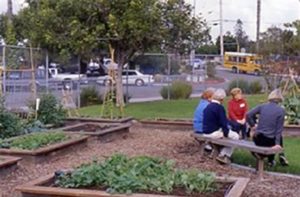To make your school garden a reality, you first need to build a team to support the effort, identify sources for funding the project, and recruit and train volunteers to help.
It takes the help of everyone – not just one or two interested teachers – to make a school garden work successfully. From the administrators who provide overall support, to the teachers who direct meaningful activity, to the parents who organize work parties, to the maintenance staff who may assist with irrigation and supplies, and to students who will have ideas and enthusiasm to share, everyone has a role to play. Working together as partners, they will be connected to the garden and ensure their commitment to its success.
To get started, you might network by making a presentation at a Parent Teacher Association meeting or a faculty meeting to determine the interest level and build support. The last section of this guide describes specific ways classroom teachers can integrate learning in the garden into the curriculum. You can showcase this valuable information to help build enthusiasm.
Request a Master Gardener consultant if you do not already have one. They may be able to assist with a small meeting or help you arrange for a speaker. See a list of speakers in the Speaker section of the Master Gardener Website. You can also use one of our Gardening with Class Conference PowerPoint presentations such as retired local pediatrician, Dr. Cynde Lane’s “Children Are Healthier, Happier, and Smarter When They Garden” which shares research supporting the benefits of gardening. Another motivational presentation would be to show a video on the History of School Gardens from the Library of Congress. Go to the Presentation section of the School Garden website for the complete list.
Include the parents, teachers, students, maintenance staff and administrators in a brainstorming session to get ideas and identify hurdles to overcome. From the group who meet to brainstorm, select individuals from each constituency to serve on a steering committee to guide in the planning and implementation of the garden. The team will set goals and objectives and provide guidelines for those responsible for bringing the garden to fruition.
First and foremost, don’t try to start too big or move too fast. You will need to build ownership and responsibility for all aspects of the garden. As your garden plan evolves, a summary of the progress will help keep administrators informed.

The summary might answer these questions.
-
- Why have a school garden program? What are the benefits?
- What are the goals and objectives?
- How will you evaluate your success?
- Who is providing the leadership?
- Who will be on the steering committee and what is their role?
- Has a site been identified?
- How much space is needed?
- How will the students be involved?
- What tools and garden supplies are needed?
- How much money is required and have funding sources been identified?
- What is the length of the program?
- Which teachers are enthusiastic?